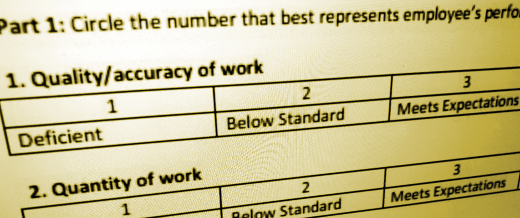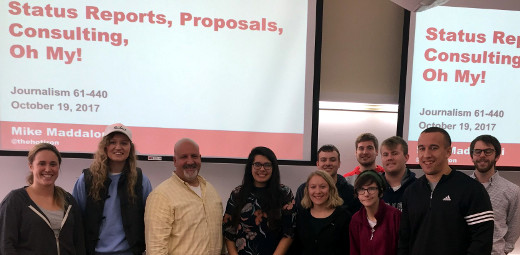Penalizing Managers For Giving Bad Reviews As Afterthought

As the new year starts, for many it is also the start of the annual review process with their employer. Where this process varies from company to company, typically it entails creating goals for the coming year, taking into consideration the goals for the team, organization, group etc. and then at the end of the year measuring if you met those goals or not along with feedback that was accumulated throughout the year.
Ask any person who goes through this process and they will likely tell you they would rather spend time standing in line at the DMV! Many people feel it's a waste of time, not only in the fact that they have to spend time working on it but also at the end of the year a couple of things typically happen - one, they don't get a raise or a bonus, and two, for the first time they learn at the end of the year of something that happened months ago or even earlier in the year.
When you get written up on something in December that happened in March, how can you really do anything about it, nine months later, to affect any change? In other words, the performance appraisal process is broken, and I have an idea to fix it -penalize the manager that gives you a poor review or feedback at the end of the year as an afterthought when they had the opportunity to tell you earlier.
Say what?
If you think about it, at the end of the year when someone is giving you a review, their own personal review doesn't necessarily reflect yours. It should, for a manager should be measured on the overall performance of their team, as they should be ensuring their team is excelling at all times. Some manager do believe in this (including, fortunately, the manager I have now), however many managers don't want to be bothered by this throughout the year and as a result giving a poor performance review at the end of the year is really no skin off their teeth and comes naturally to them. Sometimes that poor performance review is based on asking others who have worked with you to provide their input, which is often referred to as a 360° review process. Even when organizations say they have a "immediate feedback mechanism" to let people know when they do well or when they do poorly, it rarely happens this way. Finding out about a problem at the end of the year when there's really nothing that can be done about it serves nobody well.
If the person giving the negative feedback is giving it too late, it is they themselves that should be marked down for it in the end of the year process. This gives the person giving the poor review skin in the game and makes them part of the solution. The whole idea is to inform people at the time something happens that something was unsatisfactory or could've been done better or could've been corrected. When it's given at that point, the person that has the opportunity to make the correction, discuss impacts on their workload that impacts their success, identify the need for education or training or greater organizational issues that need to be addressed that the manager may not even be aware of, et. al. The person and their manager or whomever is giving the negative feedback can then together put a plan in place to lead to success, along with a timeframe and measurement.
Been there, wish it was done
Many times throughout my career I have been on the receiving end of negative feedback too late to do anything about it. When I asked why nothing was brought up sooner, I was never given a definitive answer, namely as the review process did not require it. On the flipside, I have had many managers who gave me continuous feedback, comments, adjustments, etc. as I worked with them, and this was not only greatly appreciated but led to my success and the success of the project I was working on. I also hear this from friends and colleagues that hear of such late-in-the-game feedback they can do nothing about, which simply makes the workplace even less tolerable.
Deconstructing Giving Timely Feedback
Why not strike while the iron is hot, and give feedback while it is fresh, meaningful and can produce a positive outcome? This takes facing issues head-on, something many managers may not be comfortable with or other senior people don't want to be bothered with. By making these mid-game corrections, it allows everyone to succeed, and may also impact the bottom line of the team or organization. This investment in one's team is as important as any training or materials you spend money on them, and can reap even greater rewards.
This is from The Hot Iron, a journal on business and technology by Mike Maddaloni.
Did you enjoy this? Subscribe to The Hot Iron by RSS/XML feed or Read by Email.
Business • Strategize • Thrive • (0) Comments • Permalink
The Secret Life Of Old iPhones

When the spotlight was shown on Apple’s “feature” to reduce the power of later model iPhones to compensate for degrading batteries without the owner’s knowledge, the tech giant’s remedy for this, accompanied by an apology, was to reduce the price they charge for a replacement battery from US$79 to US$29. A future upgrade to the iOS operating system will allow owners to disable this “feature” which should close the loop on this issue.
Like any action, there is always a reaction, or maybe 2 or several. In this case, Apple’s reputation has lost a little more of its luster, continuing what many have seen in a decline of their public perception since the death of founder Steve Jobs. No iPhone owner will be surprised if they receive an email or letter in coming months about a class-action lawsuit against Apple. I would add to this an observation I made when I was packaging up and sending in 2 iPhones for new batteries – a new life for otherwise “outdated” devices that may impact their future sales.
Reasons for Upgrade
Whether it’s a car, house, clothing or a smartphone, we all have reasons for upgrading to a newer model when available. On one end of the spectrum are more functional reasons, such as the “need” for new features – in the case of a smartphone, a faster processor or more memory. On the other end are reasons more for “form” or simply the desire to have the latest and greatest of whatever it is. Where I know people in the latter category, I know more that, especially with the rising cost of these devices, are sticking with older models.
Typically, these decisions were merely personal. With the lower battery cost, economics comes into play. By getting a new battery for around $30, you are in essence getting a new, older model smartphone. If you still want to upgrade to a new model, by making a small investment you can conceivably have a more valuable older model device, or one you can pass along to be used by someone else as if it were new.
As the ability to buy a used or new, older model device already exists, the aftermarket for iPhones will now expand with the opportunity for additional devices to be available in it. Or in my case, the demand for buying a new or additional devices has decreased with additional, well-suited devices, available to be reused for a lower cost.
Digital Hand-Me-Downs
Recently I got a new iPhone 8 mainly for the memory, as my iPhone 6’s paltry 16 GB was forcing me to delete apps just to take a few videos of a few minutes in length. And of course, the battery was spent to the point where I had to charge it several times a day, not to mention carrying a spare battery with me all the time. Despite these drawbacks of the 6, it was in great physical condition, and would be well suited for someone else to use.
Such a reuse is going to happen, as the device will be used by a family member who is upgrading from a flip-phone. I have sent it and paid the approximately $30 (I believe there was tax on top of it), once I get the phone back I will set it up for this family member as their more-than-perfect entry into the world of smartphones. Other older models of iPhones are already in use in my family, as my kids use them as WiFi devices and without a SIM card, after I followed what I shared before on how to best setup an iPhone for this purpose.
With the number of iPhones sold over time, there’s a demand for the new batteries. I personally ordered and sent in 2 iPhones, a 6 and a 6S, as I no longer live within walking distance of an Apple Store. Where I sent in the 6 before the 6S, the 6S came back within 3 days. Looking into it, there is a shortage of 6 and 6+ batteries. Apple’s Web site gives me no indication my replacement is pending for this reason though. Once again, a spotlight is being shone on Apple that they have to react to.
Deconstructing a New Life for old iPhones
How will this new life for these iPhones impact the market for new ones from Apple? It’s hard to say exactly. Technology today is made to be disposable, as repair costs will typically cost more than buying a new item. However, with the cost of the new iPhone X at US$999 or even the new iPhone 8 at US$699, paying thirty bucks for a new battery is almost a no-brainer, whether you personally need the device or are looking to sell or hand it off to someone else.
This is from The Hot Iron, a journal on business and technology by Mike Maddaloni.
Did you enjoy this? Subscribe to The Hot Iron by RSS/XML feed or Read by Email.
Mobile Technology • Strategize • Technology • (2) Comments • Permalink
7 Blog Topics Written in 2007 That Are Still Relevant Today

Back when this little blog from which you are reading this post turned 10 a year ago, I started thinking about what I have written over these years, especially that first year. As a new writer at a time when social media was still in its infancy, I wondered what topics or “hot irons” I decided to “strike” a decade ago. This led me to pour through the archives of The Hot Iron and reading what I wrote in 2007.
As it turns out it was a mix, from well thought-out articles to short pieces that would have probably been social media posts had those networks been more prevalent. In all, I made 236 posts over 365 days. Where some in hindsight I probably would have written differently or perhaps not at all, there were many I read which pleased me that I shared my thoughts with my new audience. Overall, there were 7 topics or themes which I covered back then that I feel are still relevant today, and I would like to share them with you on a short trip down memory lane.
1. Domain Names – As the genesis of this blog was from, and was to support, my former Web consulting business, coupled with the fact I felt many people knew very little about domain names, I wrote several articles on domain names that first year. Over the years, I continued to write even more about domain names because, even after over 2 decades of they being commercially available to the public, I felt then – and still today – domain names are not well understood.
Among the posts included Be the master of your own domain (name) on registering domain names in general, Own the Domain Name for Your Name to encourage my readers to register the domain name for their own name, Know Who Manages Your Domain Name as many register domains but will forget where they did so, Beware Unsolicited Invoices for Your Domain Name on deceptive practices for selling registration and Web-related services by sending what looks to be a legitimate invoice, Domain Name Owners Not Who You Would Think on missed opportunities to register domain names and Observations of German Domain Names about how this American saw domain names in action in Germany.
Ten years later, I think all of these posts and what they discuss are very relevant. As I work with firms and talk with people about domain names today, much of what I wrote could inform them, and possibly save them time, money and headaches.
2. Networking – I never took a class on networking in college or afterwards, namely for until recently there was never such a thing. What I learned about meeting and connecting with people I learned literally on the job, through trial and many errors, as well as successes. Perhaps I should have developed a class on it (or perhaps I still should?) but as a close second I wrote about several aspects of it.
Posts on networking I wrote were My Networking Event Checklist about how I prepare for networking events, Community building is up to ALL of us on why I network, Nametags Essential for Networking on why there’s nothing wrong with wearing nametags and Time to Write The Note Cards on following up with people after meeting them.
In several of these posts I mention Jason Jacobsohn, someone whom I met online then in real life after following his blog Networking Insight, which today is still a vibrant resource on the art and science of networking. Even though I no longer have my own business, the need for connecting with others still exists, and is the driver for why I recently started dMorning.
3. Opportunity Cost – Shortly after starting my business I learned quickly about trade-offs, and when you do something it often doesn’t allow you to do another. Through this balancing act I had a flashback to college and penned All I remember from Economics 101 - Opportunity Cost. Where opportunity cost has come into play for much of my life, as it does for most of us, it was intensified when I was the boss and sole staff of my business. This discipline was an on-going effort, and helped by seeking the counsel of other small business. As time went on, and jobs replaced my business and my family grew, recognizing the opportunity cost of one decision over another became even more important in my life.
4. Customer Service – The challenges I faced as a small business owner, I learned, were not that much different than those faced by much larger organizations. However I was always stunned how an entity with many, many more employees could still miss the mark on things that, to me, were obvious. I thought that then, and sadly I still do today.
In 2007, JetBlue Airlines had an incident where passengers were stranded on an airplane. During a discussion on this with a colleague, an idea popped into my mind, which I wrote in A Free Idea for David Neeleman, an open letter to Neeleman, the founder and then CEO of the airlines, and I offered to him this idea. I have no idea if he, or any other airline CEO, ever read it. But by hearing the customer services disasters airlines still experience in 2017, my guess is not.
5. Accessbility – My first exposure to Web site accessibility came when I helped a friend who is legally blind with his PC. This was a rare case of providing tech support to a friend that had a benefit – learning the world of accessibility tools. I learned about JAWS, a leading “screen reader” which literally reads aloud what is appearing on the screen – be it icons, a menu or what is in a Web browser. Where this was great to be exposed to, I also learned of the challenges he faced with using the Web – most Web sites are not designed or programmed to make it easy for someone who is visually impaired to navigate and use them.
I wrote specifically about my experiences with my friend’s computer in a post called Unintentional Unusability where I barely scratched the surface on many areas, and mentioned how a design decision for this very blog was based on this experience. It was because of this I was eager to adopt the now-defunct service Odiogo which I went into detail in the post Hear My Blog Posts.
Today Web site accessibility is something I am still concerned with and work to overcome. As technology and their tools continue to advance in some areas, they continue to lack in this particular area.
6. Giving Back – As giving back to the community has always been a big part of my life, I made sure to include it when I came up with a list of “gift ideas” which were simply promotions of my clients. Where the idea was to send business their way so they would ideally send more business mine, I wasn’t betting the farm on this tactic, and it was probably good that I didn’t either!
Among the posts I wrote was one that would only send a good feeling back to me, and needed resources to a great organization. In Gift Idea – Help Young People by Donating to YouthBuild Boston I asked people to make a donation to YouthBuild Boston, a non-profit in Boston that I have supported for years, and at the time were a pro-bono client of mine. YouthBuild Boston works with young people to help them be self-sustaining. They offer skills training in the construction trades, as well as the support they need to succeed. They are an amazing organization, and one that is well run as well. If you haven’t made all of your year-end donations, they are a highly worthy recipient today as they were then.
7. Health – When I started my blog, my business was home-based and my office was in the den. A decade later, I am once again working from home, this time for an organization. I have a nice short commute, but it is a commute where I walk and sit, and sit for a while. When I came upon the post I wrote Walk to Work Even If You Work From Home, it reminded me that I need to get off my butt more during the workday, even when the weather is in the single-digits as it is as I write this.
Deconstructing What I Wrote 10 Years Ago
As time goes by, some things remain a constant, which I found in re-reading what I wrote over a decade ago. Many issues and thoughts I had then are top of mind today, and I this to the fact they are part of who I am and what I believe in. My quest for people to learn, understand and be able to use technology in a calm, connected, active and charitable world is a journey I am still on today. As I continue my blog into its second decade, topics I will write about will likely include those mentioned above.
This is from The Hot Iron, a journal on business and technology by Mike Maddaloni.
Did you enjoy this? Subscribe to The Hot Iron by RSS/XML feed or Read by Email.
Blogging • Business • Strategize • Technology • (0) Comments • Permalink
My Guest Lecture On Consulting at University of Wisconsin – Oshkosh

Last week I had the honor to guest lecture to students at the University of Wisconsin – Oshkosh (UWO) on the topic of consulting. As the students are working on group projects where they consult to organizations on the Web and social media, I was thrilled to be asked to share my experiences, stories and advice on consulting and working in technology.
The class, Application of New & Emerging Media, is taught by Dr. Sara Steffes Hansen, associate professor and chair of the Department of Journalism at UWO. The class is a required course for the Interactive Web Management (IWM) major, and also part of the curriculum for journalism and public relations majors. The interdisciplinary IWM program combines journalism, business and computer science courses to prepare students for digital careers, where all of these skills are vital.
With 10 students in the class, it was a good setting to talk on this topic of consulting, as well as the upcoming deliverables for their project, including an interim status report and a proposal to the client at the conclusion of the semester. I talked about the commonly-accepted description and roles of consulting, my take on it, as well as real-life examples (with client names properly masked) of positive and not-so-positive experiences throughout my career which spans now a quarter-century. As nobody nodded-off in class and the questions posed by the students were of a high caliber, I am hoping they got as much out of the time as I did.
Dr. Hansen said the students handed in their status reports this week, and discussed the aspects of customer service and risk. She added, "the students applied those real-world examples and consulting essentials from your presentation to their own communication efforts with clients. They could articulate the management of risk for the unknowns in their projects, which is a part of any Web, eCommerce or social media endeavor. It was nice to see the students enjoy their consulting roles in this discussion."
This is the second time I have given a guest lecture in one of Dr. Hansen’s classes. Two years ago I spoke to her class, incidentally a pre-requisite of this one, on the topic of blogging. Where the last time I remotely spoke to the students using the Personify technology and a 3D Web camera, this time I was in person in the classroom, the method I prefer much better.
I have posted the slides from the lecture on SlideShare, and you can view them embedded below or view them at this link on SlideShare’s site. On slide 11, I selected 3 famous people to help describe proposals – can you guess why I chose them?
(photo credit – Dr. Sara Steffes Hansen)
This is from The Hot Iron, a journal on business and technology by Mike Maddaloni.
Did you enjoy this? Subscribe to The Hot Iron by RSS/XML feed or Read by Email.
Announcements • Business • Strategize • Technology • (2) Comments • Permalink
Expand Your Twitter Followers In 3 Steps
Whether you are new to Twitter or have been using it for years, having a list of followers has always been, and continues to be, important to the social network. Where all public tweets are readable by all, most people engage with those who they follow and who follow them. This engagement makes using Twitter worthwhile.
Like with anything, quality engagement is better than quantity engagement. This is measured directly by likes and retweets of what you post, as well as replies and conversations with others. Indirectly, it can be measured in traffic to your Web site and offline in, for example, new customers or increased sales.
People often asked me, how do you get followers? “Getting” followers – real human beings, that is – is a process, as ideally you want people to want to follow you. In some cases though, people may simply not be aware of who you are. This is why I present these 3 steps to expand your base of followers. Of course, there are no guarantees your list of followers will balloon overnight, but these are geared towards getting people’s attention to you.
1. Decide who you would like to follow you – This offline strategizing is you thinking about who you would like to follow you. For people who have businesses or are in business, they will relate to this as it is similar to who their target audience or customer or other demographic information is. For some, that is a great place to start, and for others it can be who you would like to read your blog or those who work in the same industry as you.
Write this down – your target followers. Keep this by you as you go through the following steps.
2. Follow those who you want to follow you – Now that you have defined who, look for them, and follow them. Many times when people think of social media engagement, they purely look at it from their own vantage point. However, take a 360-degree approach – would the people who you want to follow you actually want to?
By following them, you are expressing interest in them, and in most cases, letting them know who you are. The hope is they will see you following them, look at your profile and what you have tweeted, and then follow you back.
So how do you find them? By searching – either for specific people or terms, words hashtags – for whatever ways you can think of to find people, businesses, organizations, whomever that you want to follow, and to follow you back.
3. Follow those who follow those you want to follow you – Apologies for the mouthful there… as you are targeting people to follow, why not check out who they follow as well as who follows them? This is a great wat to expand the scope beyond merely searching, as many times potential targets for your following may not come up in a search for a variety of reasons, including their profile not matching what you have been searching on.
Everything in moderation
One consideration to make when you follow people is there are limits imposed by Twitter to the number of people you can follow, and you can read more on these limits on Twitter’s help site. To start, you can follow up to 5,000 people. After that, you need to have more followers in order to follow more that that number. There is a ratio to this, though Twitter does not specifically disclose it. Of course if you hit the limit but want to follow others, you can always unfollow accounts to make room.
Deconstructing Twitter Followers
Wouldn’t it be great to have tons of Twitter followers? But if you think of it from the point-of-view of real life, it’s a similar approach to friends in real life – they are relationships you establish and maintain. Sometimes you are the one initiating it, and this is where following others you want to follow you comes into play.
This is from The Hot Iron, a journal on business and technology by Mike Maddaloni.
Did you enjoy this? Subscribe to The Hot Iron by RSS/XML feed or Read by Email.
Build • Social Media • Strategize • Thrive • (0) Comments • Permalink




